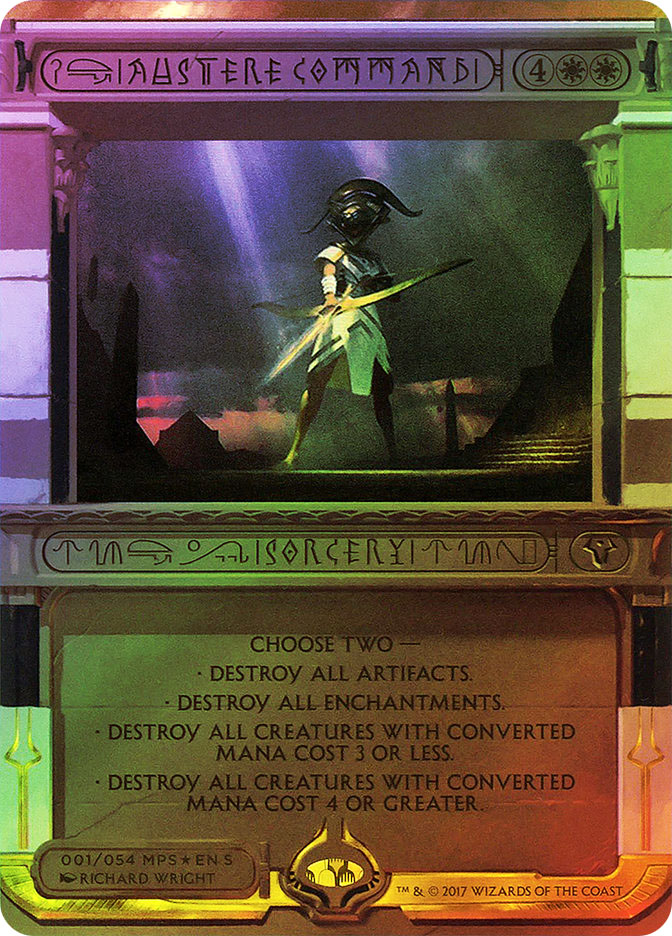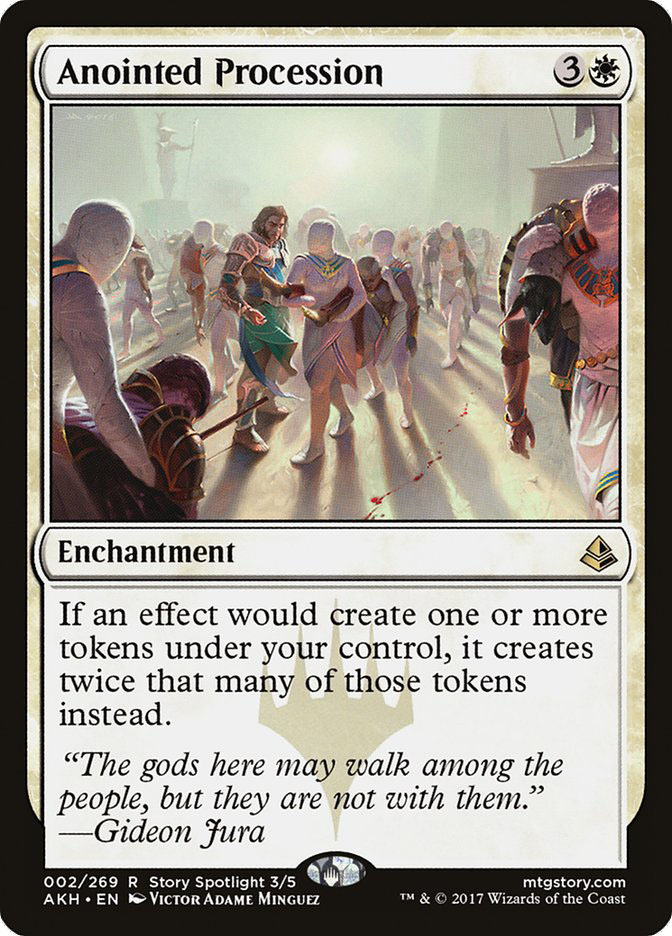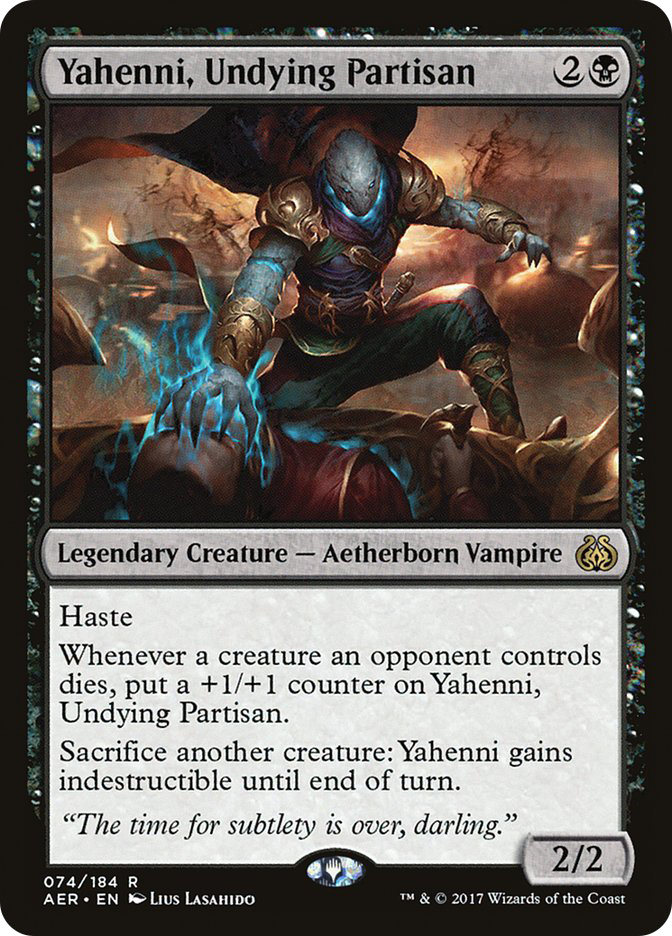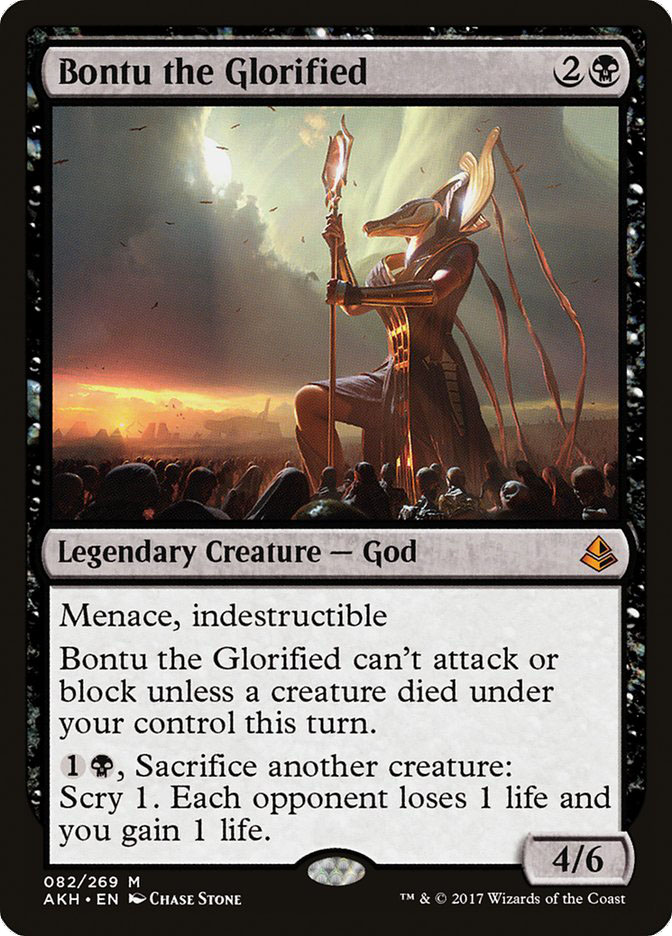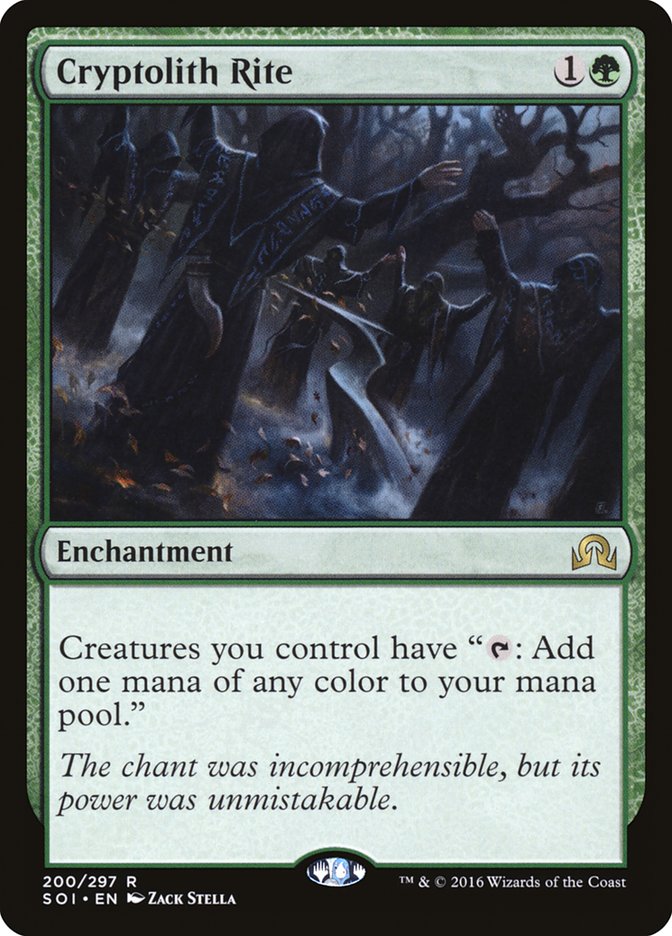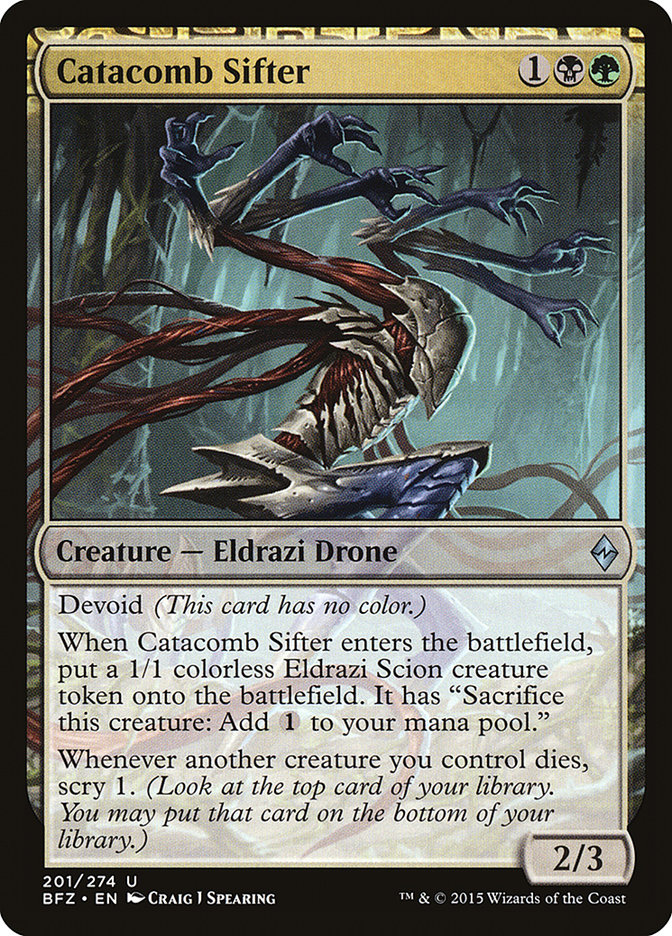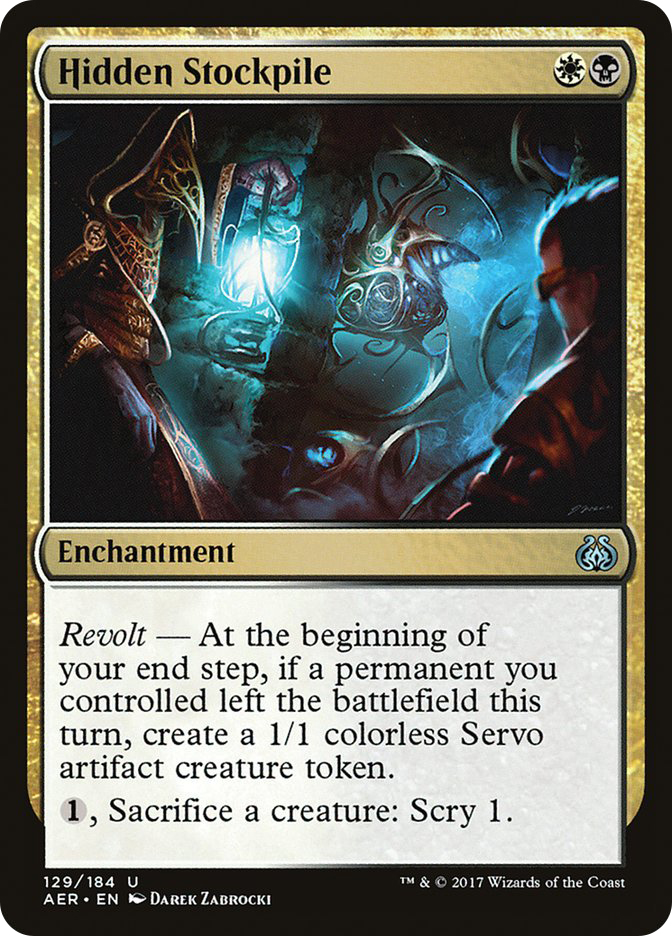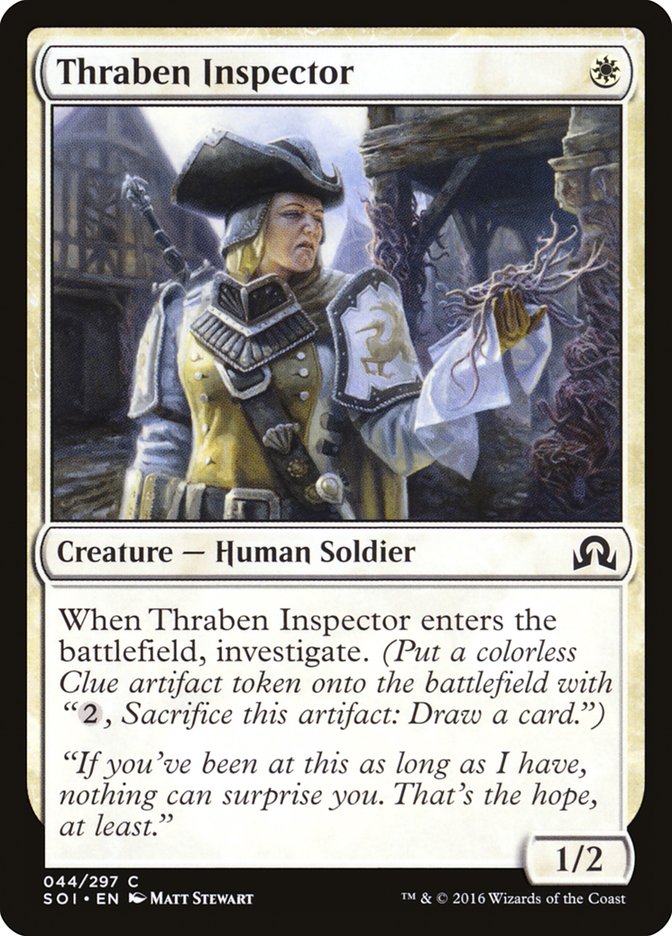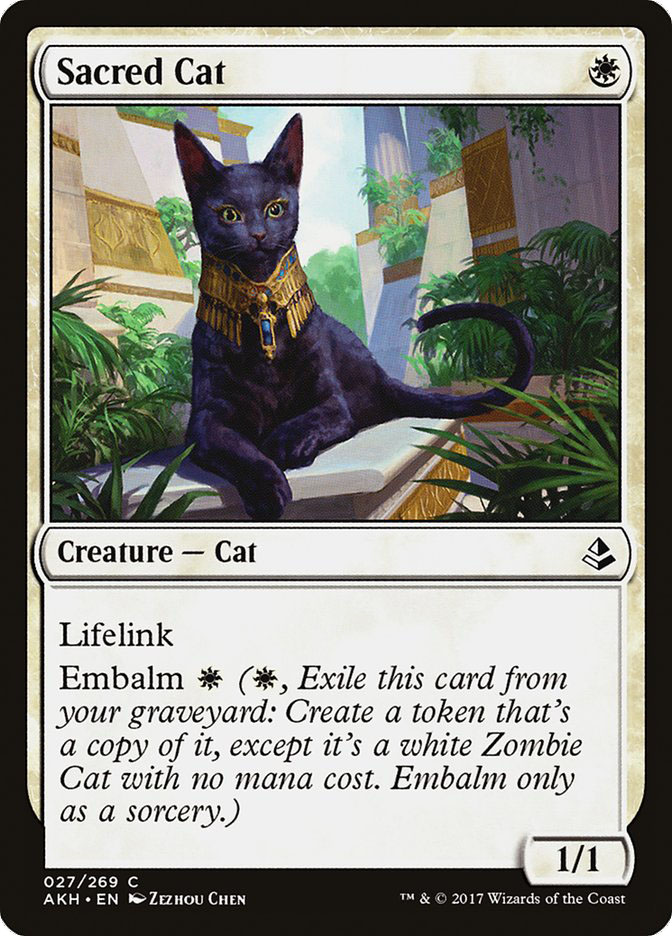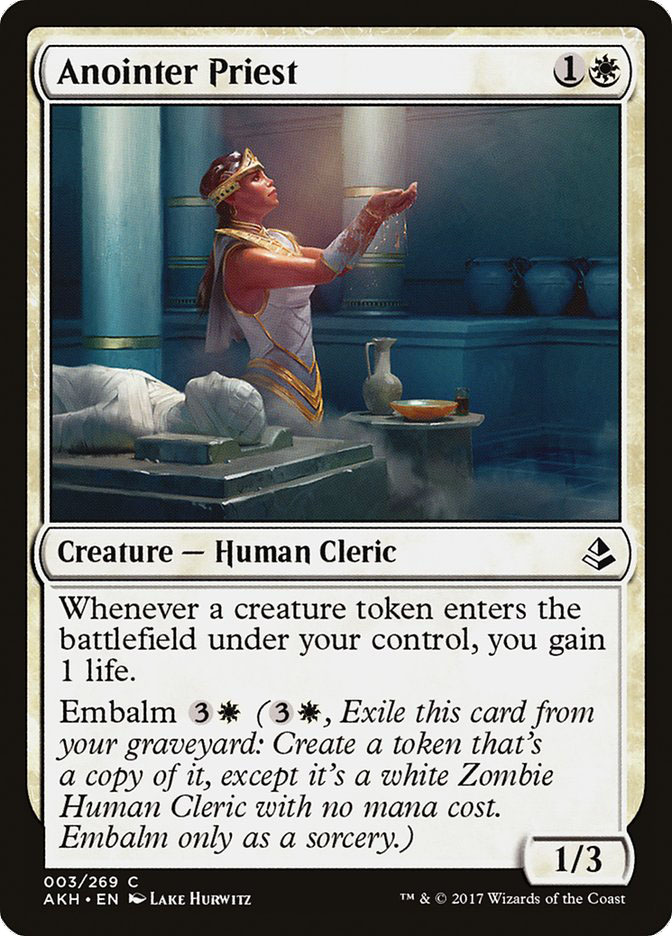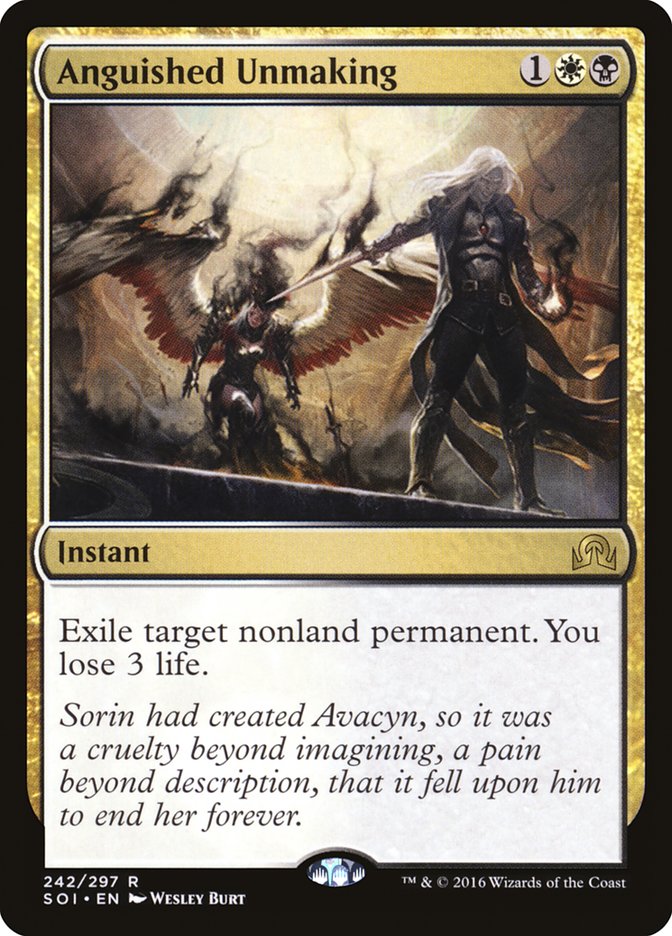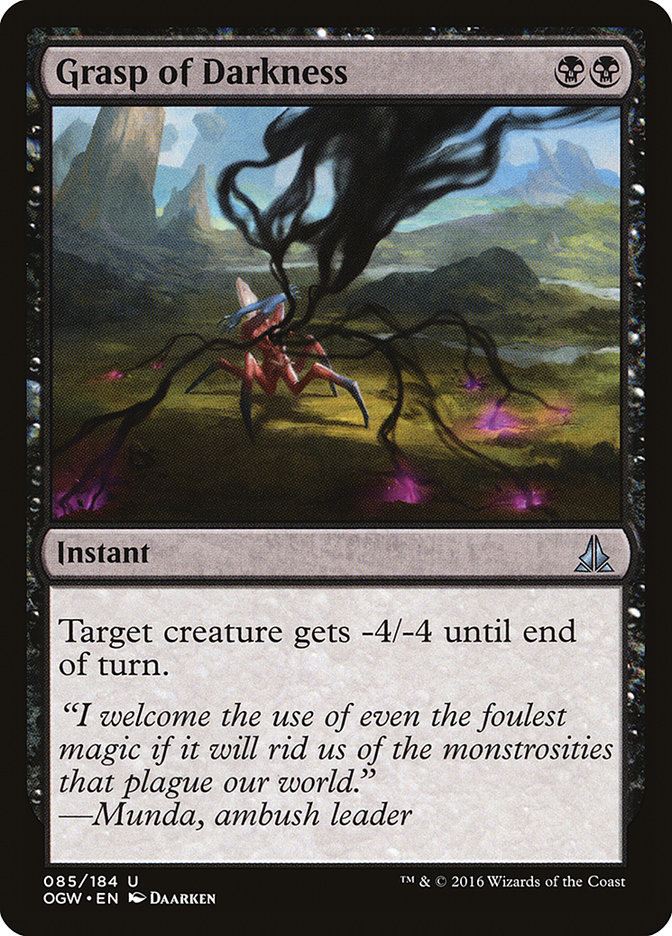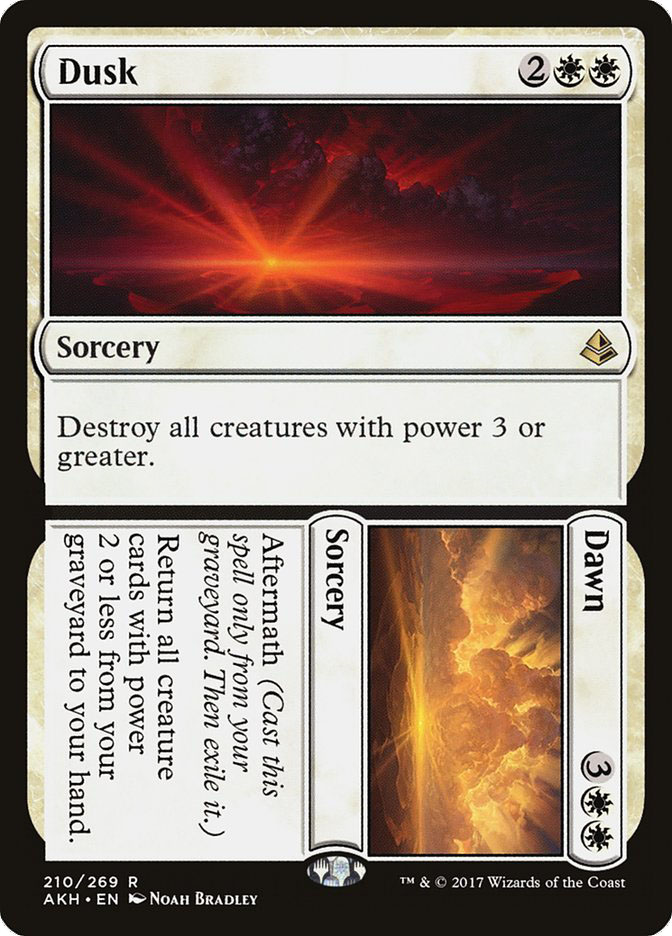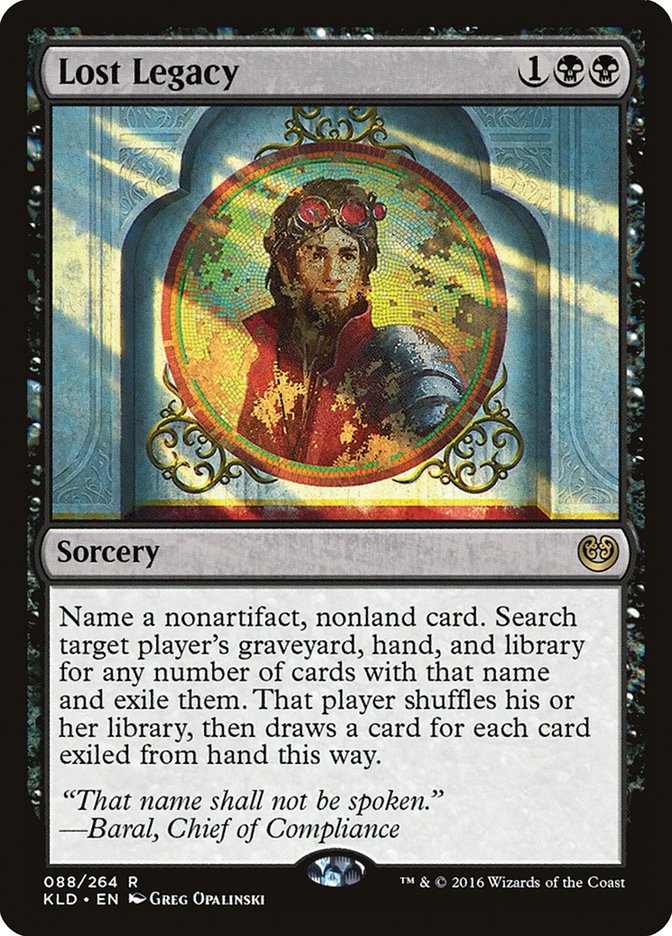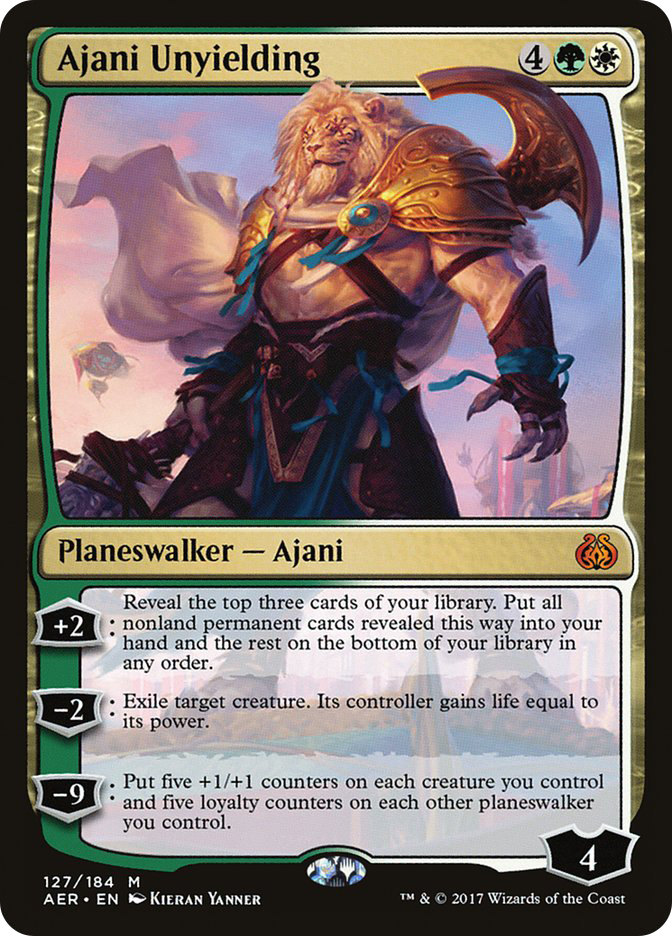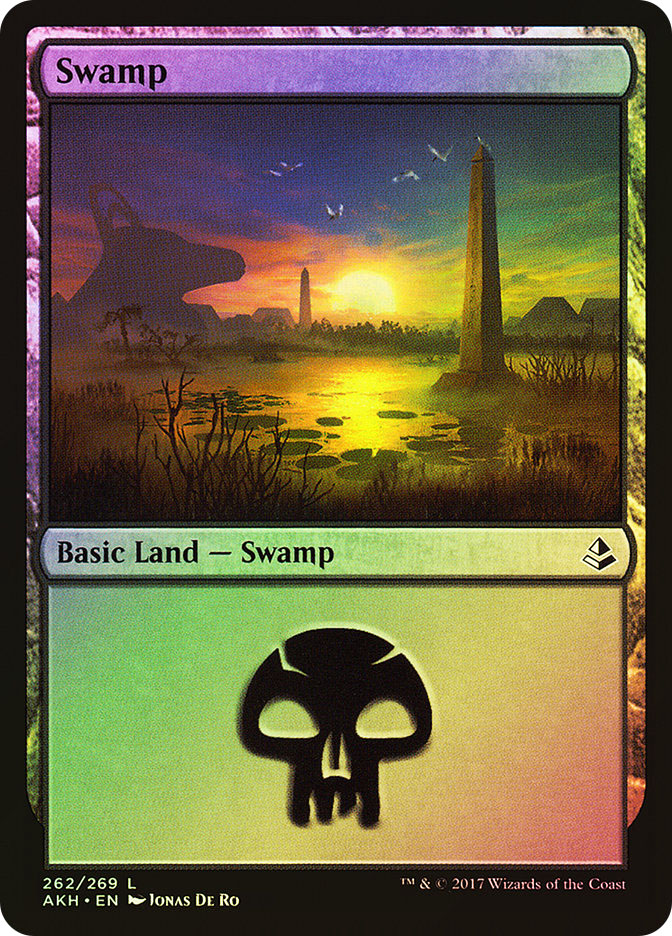I had an absolute blast at
playing an incredibly fun and extremely sweet deck of my own design. Let’s
start with my final decklist, just to get that out of the way, and then
I’ll go over how it came to be, what it does, why it has the cards it does,
and how to play the major matchups.
Creatures (16)
Planeswalkers (3)
Lands (25)
Spells (16)
Sideboard

So, the backstory:
At the Amonkhet Prerelease, I watched a player play a second
Anointed Procession in a deck with several creatures with embalm, and the
threat of suddenly making four creatures if any of his creatures died made
things very awkward for his opponent (until she drew an Invocation Austere
Command, but that card’s not Standard-legal).
I was impressed by the power of multiplication and decided to try to build
a deck around it.
My first attempt was just white and black because I like to always play as
few colors as I can get away with. I had Start, which I think is actually a
very good card (you’re basically paying an extra mana on Raise the Alarm to
draw a card; that’s close to as good to a Ruinous Path that can only hit
creatures), but there are actually not that many creatures you want to
spend a lot of mana to kill at sorcery speed in this format.
Yahenni, Undying Partisan was pretty solid but considerably weaker than
Catacomb Sifter, as well as a lot of speculative cards that I played one
copy of just to try, like Bontu the Glorified and Oketra the True, both of
which the deck can use very well. However, neither of them seemed like the
best way to spend extra mana, and I didn’t really need a big creature most
of the time, though it’s possible that they could be good in the deck.
Especially Bontu, just because Gideon and Anointed Procession are stiff
competition at four mana.
I liked the two-color version, but without Cryptolith Rite I found that it
could be too slow to get everything onto the battlefield, and Catacomb
Sifter is a great fit for the curve and power level of a deck that has a
ton of great synergies. So I determined that the green was worth it, but it
took me far too long to realize that I needed a 25th land to make
everything work smoothly and that I could easily afford the extra land
because all the scrying would still allow me to draw well in the mid game.
I played the deck on Magic Online a lot, and my major takeaway was that
people really had no idea how to play against me. The reason is
that when you’re playing against me, my deck looks like a creature deck: I
do a lot of attacking and blocking, and I’m playing Cryptolith Rite.
Traditionally, Cryptolith Rite decks are very weak against cards like
Fumigate. Almost all of my opponents who had access to Fumigate brought it
in against me. The problem is that I’m not actually a creature deck–I’m an
enchantment deck. My engine happens to produce creatures, but the important
part is the engine, not the creatures. If you kill the creatures, it only
really sets me back a turn or two, but it doesn’t interact with my actual
strategy at all.
The other major failing on my opponents’ part is not realizing that I have
inevitability if they can’t remove my enchantments. It doesn’t matter how
many Zombies they make with Diregraf Colossus or how many cards
Cryptbreaker draws, and it doesn’t matter how many Winding Constrictors
they have to add extra counters to their walking Ballista.
If I have Cryptolith Rite, Hidden Stockpile, and Anointed Procession, I’ll
just draw Hidden Stockpile, Anointed Procession, Anointer Priest, or Gideon
every turn, and I’ll quickly get to the point where I’m gaining 16 or 32,
or 64 life a turn while making around eight creatures a turn, and then I
can flip Westvale Abbey or make a Gideon emblem and attack whenever I get
far enough ahead, which will always happen eventually. After sideboarding,
Dusk really punishes the other creature decks, like Zombies and B/G Energy,
that try to build a big battlefield with me, because eventually I can just
kill all of their creatures and attack.
Individual Card Choices
This one should be pretty clear, since it’s basically a staple of most
white decks in Standard, but it’s doing a tremendous amount of work here.
Obviously it’s an early blocker while you’re trying to set up, and it’s a
one-mana creature that you can tap for mana if you have Cryptolith Rite.
The Clue is far more valuable here than in other places because of how it
interacts with Hidden Stockpile and Anointed Procession.
Hidden Stockpile has a revolt trigger. Often, you’ll have to sacrifice one
your creatures to trigger revolt, but any time you can trigger it without
sacrificing a creature, you can extend your board without needing multiple
enchantments, which is a great way to get set up in the early game.
Anointed Procession doubles all tokens, not just token creatures, which
means that it doubles Thraben Inspector’s clues. This means that Thraben
Inspector actually becomes a powerful card draw engine once your deck is
firing on all cylinders, and eventually becomes your best card. In one
round in the PT, I made eight Clues with a single Thraben Inspector, and
used Cryptolith Rite to immediately sacrifice five of them.
This is the weakest card in the deck, but it serves some very important
roles. First, it’s just another one-drop to make sure your Cryptolith Rite
can get you going as fast as possible, potentially allowing Gideon, Ally of
Zendikar on turn 3, but it’s most important for its interaction with Hidden
Stockpile.
In the early game, you need to get your Hidden Stockpile going if you don’t
have a Clue or an Evolving Wilds, which means you’ll often need to
sacrifice a creature (or play Gideon, Ally of Zendikar and make an emblem).
Sacred Cat allows you to do this very cheaply and it comes back immediately
for very little mana to let you start going wide. Also, if you don’t have
Anointer Priest, but you have Anointed Procession, it can function as a
backup lifegain engine to buy time.
It’s most important against control decks. It’s a cheap threat that’s often
not worth dealing with, which helps you put the pressure on. This is
important because your goal is to force them to act so that you can resolve
something important, but also, if you resolve Hidden Stockpile, which is
plan A, they might try to stop you from using it by keeping your board
empty; but the fact that Sacred Cat can give you a token even if they
counter it makes it very hard for them to stop you from beginning to scry.
Also, when your opponent plays a sweeper, it can shut down Hidden Stockpile
even if you have multiples, and you’ll need to find a way to get a creature
or Evolving Wilds out to restart your engine. This makes it very important
to try to keep a Sacred Cat in the graveyard so you can quickly rebuild in
a way that gets around counterspells if your opponent plays a sweeper.
This is an absolute linchpin of the deck. Without Anointer Priest, you’d
just die to fast starts or creatures with flying or trample. For a little
more mana, this does everything Sacred Cat does, but more importantly, it
gains massive amounts of life in the mid game. If you return it to the
battlefield with two Anointed Processions in play, something I often try to
set up, you immediately gain sixteen life. You’ll also often have a Hidden
Stockpile at that point, which will net you an extra sixteen life at the
end of your turn. I often end games with around 70 life, and breaking a
hundred isn’t uncommon.
This is an all purpose player that really ties the room together. It’s big
enough to block usefully and threaten Planeswalkers, it doubles your
scrying with Hidden Stockpile, or it gives you a backup scry engine if you
don’t have a Hidden Stockpile. It also lets you cast your four mana spells
faster, since your fourth land often enters the battlefield tapped.
You’re favored against everyone going long, so you need to buy time to get
there. You can’t let people keep Heart of Kiran or Cryptbreaker around.
Also, you’re by far the best deck at using Fatal Push, since you intend to
trigger Revolt every turn anyway. It’s extremely important to have a play
that’s this tempo positive to get away with taking a turn off and spending
four mana to play an enchantment that will pay future dividends after
playing a bunch of creatures that are too small to really impact the board.
This deck doesn’t have Duskwatch Recruiter or any big spells, so it’s easy
to wonder how we can make use of this much mana. Don’t worry. Between
Hidden Stockpile, Westvale Abbey, and doubled Clue tokens, it’s extremely
easy to spend as much mana every turn as you can make. Once your engine
gets rolling, you’ll often want to sacrifice extra creatures in your upkeep
to scry because finding an extra piece of your engine is so much better
than drawing a land or Sacred Cat. You can afford to do a lot of that when
the creatures can all pay to sacrifice themselves, and you’ll still have
mana left over to cast whatever you draw. It’s also crucial to flipping
Westvale Abbey quickly when you want to do that. Some of my best games have
been games where I stuck on two lands but Cryptolith Rite allowed me to
start going off. Then I just chose not to draw any more lands because
making more creatures was a better way to get more mana.
This is the best card in the deck by far and I’m extremely reluctant to
mulligan any hand with it. My favorite start is turn 2 Hidden Stockpile,
turn 3 Hidden Stockpile, sacrifice Evolving Wilds, make two tokens, turn 4
Gideon, Ally of Zendikar, make an emblem, make two more tokens. Making
tokens every turn and scrying regularly is the key that allows everything
else to work.
It’s great to have access to an answer this versatile when you can scry as
often as this deck, so that if I absolutely have to answer something
(Ulamog, the Ceaseless Hunger, for example), I can eventually. I originally
had Cast Out, because I was very optimistic about the card in general, but
this deck has too many important four-mana spells and not enough three-mana
spells, so I found the cheaper casting cost to be more important the option
to cycle, especially since this deck often doesn’t care about three life.
The card the deck is built around. I was worried that four might be too
many four-mana cards that don’t always immediately impact the battlefield,
but I knew I had to try four because they’re so much more explosive in
multiples. It just felt really weird choosing to play this card over
Gideon, Ally of Zendikar, but it’s definitely better in this deck. This is
what lets you go over the top of everyone else who’s trying to do big
things.
This is a fantastic card that works particularly well with many other cards
in the deck and provides an anthem effect for your tokens. I imagine the
question “why only three?” is far more likely than, “Why is Gideon in this
deck?” The answer is that because the creatures are so small, you’re behind
too often against other creature decks and they can just attack and kill
Gideon or force you to block with enough creatures that you’re not getting
ahead; you can only play so many four-drops before the deck gets too
clunky. Anointed Procession is more important.
The lands are pretty straightforward, Westvale Abbey is obviously fantastic
in this deck in every possible way, and Evolving Wilds helps a lot with
making the mana work in a three-color deck. It’s also very important for
triggering Revolt in his deck.
Sideboard Cards
If your opponent knows how to play it, Mardu is one of your worst matchups
because they can kill you before you get going, so you need to be able to
kill Heart of Kiran and Toolcraft Exemplar every time. Against any
aggressive creature deck, you want to board up to eight removal spells so
that you can buy time to get all your pieces together.
This is just a win-the-game button against any midrange creature deck.
Your midrange value plan is so much more powerful than Aetherworks Marvel’s
Whirler Virtuoso plan that the only card you care about is Ulamog, the
Ceaseless Hunger. Once you exile these, I really don’t know how they can
win if your draw is at all functional.
These come in against Aetherworks Marvel to answer Ulamog, the Ceaseless
Hunger, Aetherworks Marvel, and against U/R control to answer Torrential
Gearhulk or any smaller creature they side in, like Dragonmaster Outcast or
Thing in the Ice. Because neither of those decks are really threatening
your life total, it’s safe to have a lot of these.
This is a super fun card for going long, but really, it should just be
another Anguished Unmaking.
Seven cards in the sideboard cost BB. Zero cards in the maindeck do. This
allows your Evolving Wilds to fetch a second Swamp (I’ve been siding out a
Plains for it) when you add the black cards.
I mentioned that this isn’t in the maindeck because it can be easy for
other creature decks to attack it. If your opponent isn’t playing many
cheap creatures, it’s still the best.
Talking Common Matchups
Mardu Vehicles:
Fatal Push and Anointer Priest are more important here than usual. You’ll
probably need to slow them down to get your engine going before they kill
you. This is a very bad matchup if your opponent knows to cut their removal
and fill their deck with creatures and Planeswalkers, but in my testing
against players on Magic Online and at the Pro Tour, people didn’t figure
that out. This is a huge part of the reason that I chose to play this deck
at the Pro Tour: Mardu is a good matchup if your opponent leaves in their
removal and adds Fumigate, and I expected that even at the Pro Tour, most
of my opponents would make that mistake. Unfortunately, now that I’ve
written this, your best chance is to hope your Mardu opponent wasn’t
interested in reading about tokens.
Ideally, cast Lost Legacy and name Ulamog, then just make as many creatures
as you can. If you don’t draw Lost Legacy, try to use your scrys to fill
your hand with Anguished Unmakings so that you can exile their Aetherworks
Marvels and Ulamogs. When you sideboard, you can safely cut Sacred Cat–you
shouldn’t think of yourself as the aggro deck. You’re not really trying to
race them; you’re trying to invalidate their end game and trump them with
yours.
U/R Control:
Your goal is to resolve Hidden Stockpile, Gideon, Ally of Zendikar, or
Anointed Procession. Westvale Abbey is one of your best cards. Be careful
about when you cast your important spells. Don’t run into Censor if you can
help it, don’t cast a spell you care about when they have exactly three
mana. Wait until they have four so that they have to take a turn off
casting Glimmer of Genius in order to counter it. Don’t cast an expensive
spell into six mana to let them resolve Torrential Gearhulk without risk.
If you can’t stick a reasonable engine, they have inevitability, and their
card draw will beat you because very few of your cards matter and they can
counter them. If you can get a couple enchantments down, they can draw all
the cards they want; your 1/1s will be relentless and they can’t really
stop you or kill you once you get going. Be very careful with Westvale
Abbey. Don’t run it into Disallow or Commit. You want to primarily use it
to make tokens.
Zombies:
Kill Cryptbreaker and Diregraf Colossus. Hope they draw Metallic Mimic and
Lord of the Accursed so that Dusk kills all their creatures. Pressure their
life total where you can to try to pinch Cryptbreaker draws and make it
harder for them to attack for fear of dying to a counterattack. Their
creatures are much bigger than yours. You’ll have to chump block a lot.
That’s fine, you can make more creatures than them at most stages of the
game, and as long as you make it past the early game, you’ll probably win
whenever you resolve a big Dusk.
This deck loses a lot of its strength once it’s a known entity, as my decks
so often do, but I think my plans against Zombies, Marvel, and every
midrange creature deck are very solid and robust. I’ve done very well
against all but the best U/R Control players, so I think the deck might
have some legs to it, and either way, if you like doing crazy things, this
is absolutely a deck you should try, as the battlefield in the games you
win often get extremely crazy.


